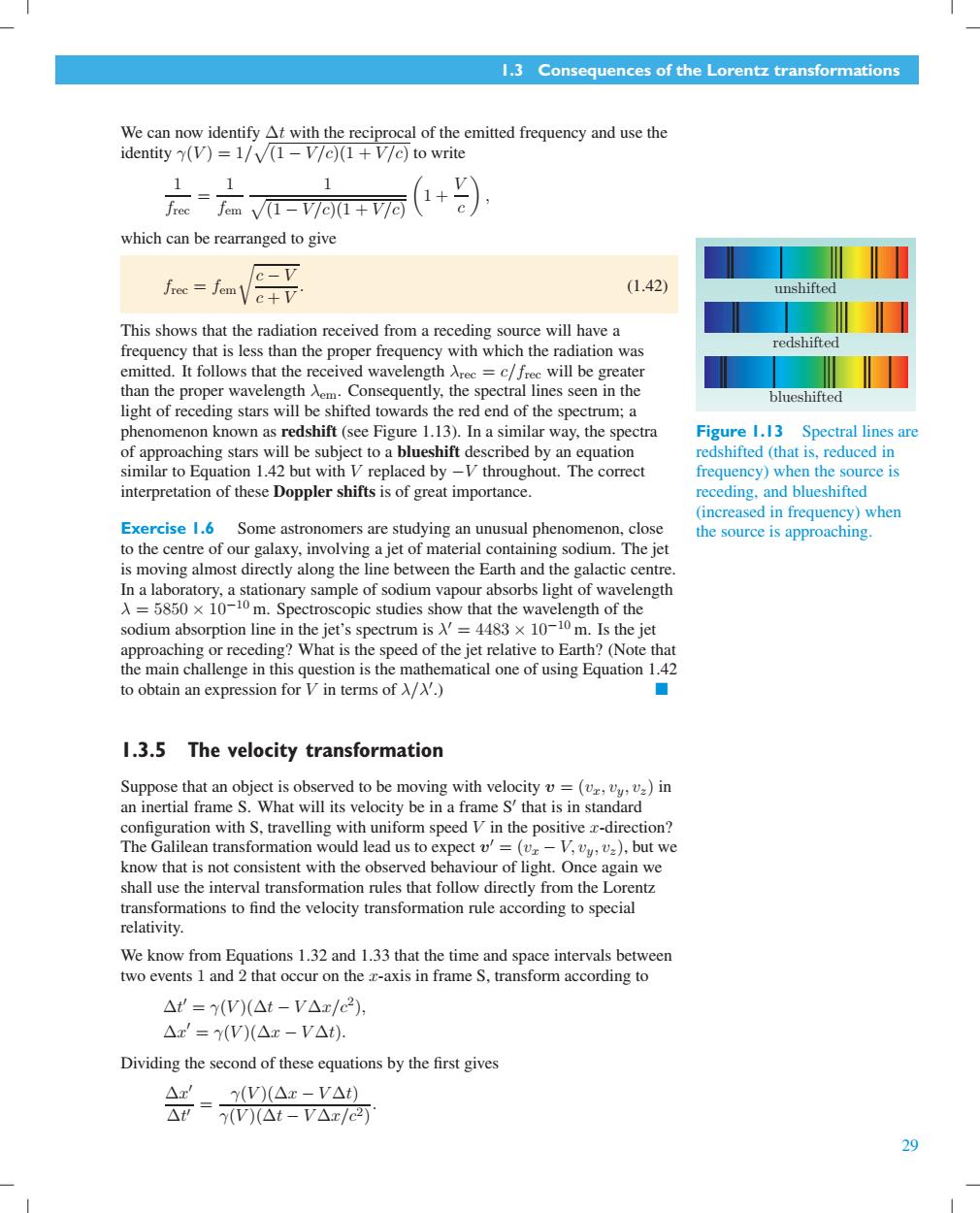正在加载图片...

1.3 Consequences of the Lorentz transformations We can now identify At with the reciprocal of the emitted frequency and use the identity (V)=1/v(1-V/c)(1+V/c)to write 11 1 =V-v7+7 +c which can be rearranged to give c-V (1.42) unshifted This shows that the radiation received from a receding source will have a frequency that is less than the proper frequency with which the radiation was redshifted emitted.It follows that the received wavelength Arec =c/frec will be greater than the proper wavelength Aem.Consequently,the spectral lines seen in the blueshifted light of receding stars will be shifted towards the red end of the spectrum;a phenomenon known as redshift(see Figure 1.13).In a similar way,the spectra Figure 1.13 Spectral lines are of approaching stars will be subject to a blueshift described by an equation redshifted(that is,reduced in similar to Equation 1.42 but with V replaced by-V throughout.The correct frequency)when the source is interpretation of these Doppler shifts is of great importance. receding,and blueshifted (increased in frequency)when Exercise 1.6 Some astronomers are studying an unusual phenomenon,close the source is approaching. to the centre of our galaxy,involving a jet of material containing sodium.The jet is moving almost directly along the line between the Earth and the galactic centre. In a laboratory,a stationary sample of sodium vapour absorbs light of wavelength A=5850 x 10-10 m.Spectroscopic studies show that the wavelength of the sodium absorption line in the jet's spectrum is A'=4483 x 10-10 m.Is the jet approaching or receding?What is the speed of the jet relative to Earth?(Note that the main challenge in this question is the mathematical one of using Equation 1.42 to obtain an expression for V in terms of A/A'.) ■ 1.3.5 The velocity transformation Suppose that an object is observed to be moving with velocity v=(vz,y,v)in an inertial frame S.What will its velocity be in a frame S'that is in standard configuration with S,travelling with uniform speed V in the positive z-direction? The Galilean transformation would lead us to expect v'=(vz-V,vy,v),but we know that is not consistent with the observed behaviour of light.Once again we shall use the interval transformation rules that follow directly from the Lorentz transformations to find the velocity transformation rule according to special relativity. We know from Equations 1.32 and 1.33 that the time and space intervals between two events 1 and 2 that occur on the x-axis in frame S,transform according to △t=y(V)(△t-V△x/c2) △x'=Y(WV(△x-V△t). Dividing the second of these equations by the first gives Az' y(W)(△x-V△t) △t= y()(△t-V△x/c2) 291.3 Consequences of the Lorentz transformations We can now identify Δt with the reciprocal of the emitted frequency and use the identity γ(V )=1/ - (1 − V /c)(1 + V /c) to write 1 frec = 1 fem 1 - (1 − V /c)(1 + V /c) ? 1 + V c @ , which can be rearranged to give frec = fem# c − V c + V . (1.42) This shows that the radiation received from a receding source will have a frequency that is less than the proper frequency with which the radiation was emitted. It follows that the received wavelength λrec = c/frec will be greater than the proper wavelength λem. Consequently, the spectral lines seen in the light of receding stars will be shifted towards the red end of the spectrum; a phenomenon known as redshift (see Figure 1.13). In a similar way, the spectra unshifted redshifted blueshifted Figure 1.13 Spectral lines are redshifted (that is, reduced in frequency) when the source is receding, and blueshifted (increased in frequency) when the source is approaching. of approaching stars will be subject to a blueshift described by an equation similar to Equation 1.42 but with V replaced by −V throughout. The correct interpretation of these Doppler shifts is of great importance. Exercise 1.6 Some astronomers are studying an unusual phenomenon, close to the centre of our galaxy, involving a jet of material containing sodium. The jet is moving almost directly along the line between the Earth and the galactic centre. In a laboratory, a stationary sample of sodium vapour absorbs light of wavelength λ = 5850 × 10−10 m. Spectroscopic studies show that the wavelength of the sodium absorption line in the jet’s spectrum is λ % = 4483 × 10−10 m. Is the jet approaching or receding? What is the speed of the jet relative to Earth? (Note that the main challenge in this question is the mathematical one of using Equation 1.42 to obtain an expression for V in terms of λ/λ % .) ■ 1.3.5 The velocity transformation Suppose that an object is observed to be moving with velocity v = (vx, vy, vz) in an inertial frame S. What will its velocity be in a frame S % that is in standard configuration with S, travelling with uniform speed V in the positive x-direction? The Galilean transformation would lead us to expect v % = (vx − V, vy, vz), but we know that is not consistent with the observed behaviour of light. Once again we shall use the interval transformation rules that follow directly from the Lorentz transformations to find the velocity transformation rule according to special relativity. We know from Equations 1.32 and 1.33 that the time and space intervals between two events 1 and 2 that occur on the x-axis in frame S, transform according to Δt % = γ(V )(Δt − V Δx/c2 ), Δx % = γ(V )(Δx − V Δt). Dividing the second of these equations by the first gives Δx % Δt % = γ(V )(Δx − V Δt) γ(V )(Δt − V Δx/c2 ) . 29